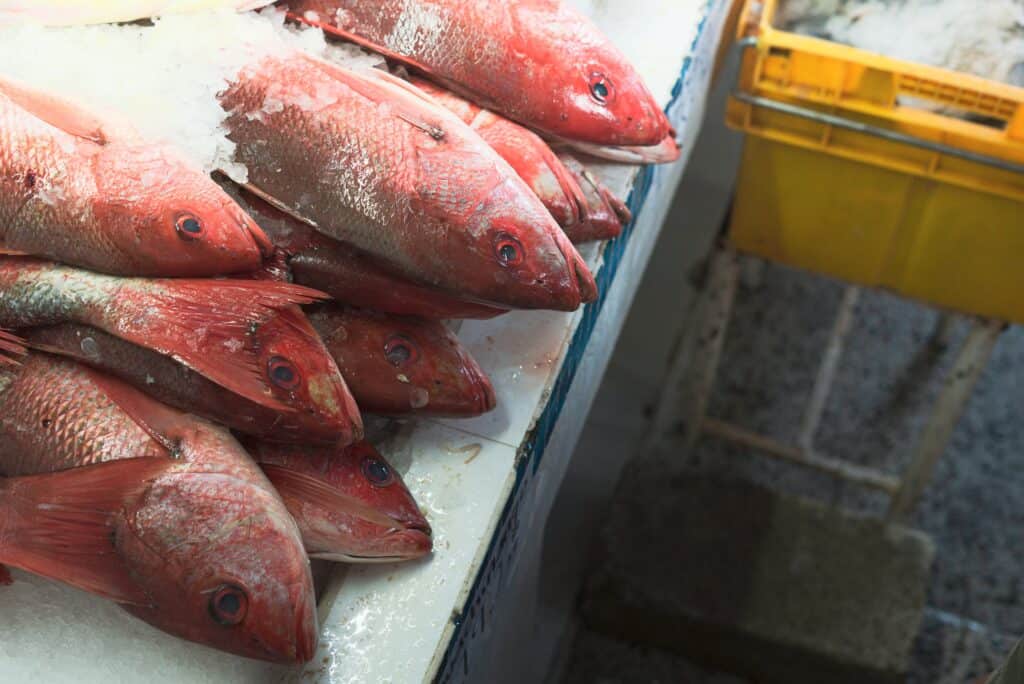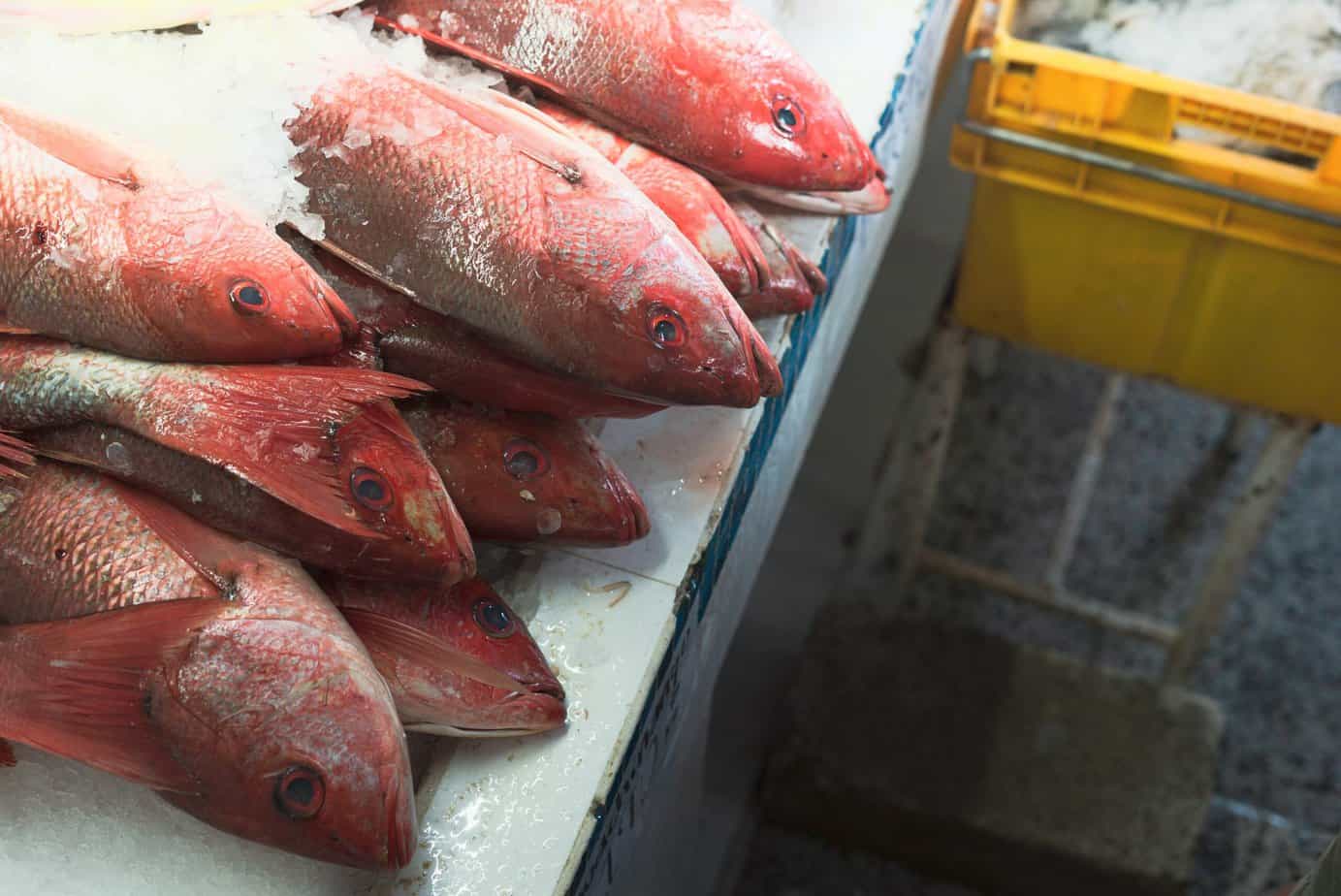How to Defrost Fish? Its quick and easy to thaw frozen fish by simply placing the frozen fish in a derost bowl and let them thaw at room temperature for 20 to 30 minutes. Ever found yourself wondering about the best way to quickly defrost fish? We’ve put together a handy guide to answer that exact question.
In this guide, we explore safe defrosting practices for fish, ensuring you achieve best results for your seafood dishes while maintaining food safety. Understanding the right defrosting techniques for fish is crucial to preserving the quality and safety of your seafood.

Defrosting fish might seem easy, but there are nuances and best practices that can make a significant difference. We will explore various methods, including refrigerator thawing, cold water thawing, and microwave thawing, each with its own set of guidelines. Additionally, we’ll highlight common mistakes to avoid, such as thawing fish at room temperature or using warm water, which can lead to bacterial growth and compromise the fish’s quality.
Our article aims to provide a detailed, informative, and valuable read for our audience. By understanding these essential aspects of defrosting fish, you’ll be equipped to handle and prepare seafood like an expert, enhancing the flavor of the seafood.
When it comes to seafood preparation, defrosting fish correctly is crucial for ensuring safety, maintaining quality, and preserving the natural texture and flavor. This section provides a detailed look at why proper defrosting is essential and highlights common mistakes to avoid.
Why Properly Defrosting Fish is Crucial
Proper defrosting of fish is key for several reasons. Firstly, it ensures safety by preventing the rapid multiplication of harmful bacteria, such as Salmonella and Listeria, which can occur when seafood is improperly handled during defrosting. Secondly, correctly thawing fish maintains its quality, preventing rapid temperature changes or prolonged exposure to higher temperatures that can cause texture changes, loss of flavor, and development of off-putting odors and flavors.
Another critical aspect is the preservation of texture and flavor. Controlled defrosting allows seafood to retain its natural properties, while quick-thawing methods like using a microwave or placing seafood under running hot water can cause uneven thawing, resulting in a less enjoyable eating experience. Evenly defrosted seafood also cooks more uniformly, ensuring it reaches the desired internal temperature without overcooking or undercooking.
Common Mistakes to Avoid While Thawing fish
Avoid thawing fish at room temperature or using warm or hot water, as these methods can allow bacteria to grow rapidly and change the texture of the fish. Instead, plan ahead for thawing, especially using the refrigerator method, which is safe but takes longer – usually a full day for a whole fish.
Another common mistake is not considering the freezer storage duration for different types of fish. For instance, fatty fish like salmon should be frozen for up to 3 months for optimal quality, while leaner fish can be frozen for up to 6 months. It’s also recommended to label your seafood with the date you place it in the freezer for better tracking.
Key Considerations for Defrosting Fish
| Aspect | Consideration |
|---|---|
| Safety | Prevents bacterial growth |
| Quality Maintenance | Preserves natural texture and flavor |
| Cooking Evenness | Ensures even cooking and optimal temperature |
| Storage Duration | Varies based on fish type (3-6 months) |
| Thawing Methods | Refrigerator, Cold Water, Microwave |
Best Practices for Defrosting Fish
- Plan Ahead: Allocate sufficient time for safe methods like refrigerator thawing for defrosting fish.
- Avoid Quick Fixes: Steer clear of room temperature or warm water for thawing fish.
- Label and Track: Mark your seafood with freezing dates.
- Understand Fish Types: Know the optimal freezer storage duration for different fish types.
- Choose Right Method: Select the appropriate defrosting method based on your needs and time constraints.
How to Defrost Fish in Fridge – Safest way to thaw frozen fish Quickly
Understanding the nuances of refrigerator thawing is vital for anyone looking to master the art of preparing seafood. Defrosting fish using refrigerator is universally recognized as the safest and most effective way to thaw fish, ensuring the preservation of quality, texture, and safety.
Refrigerator thawing involves a slow, controlled process that minimizes the risk of bacterial growth. By keeping the fish at a constant, safe temperature, this method ensures that the fish thaws evenly, preserving its integrity. To execute this method, place the fish in the refrigerator on a plate or tray to catch any drips, ideally on the lowest shelf to prevent any cross-contamination.
The time required for refrigerator thawing varies depending on the size and thickness of the fish. Smaller fillets might thaw overnight, while larger whole fish could require up to 24 hours or more. It’s crucial to plan and allow enough time for the fish to thaw completely, ensuring it’s ready for cooking.
Best Practices for Thawing Fish in Refrigerator
Ensure that the fish is properly sealed in a leak-proof package or wrap, which helps in maintaining freshness and preventing odor transfer from other foods in the fridge. Fatty fish like salmon and tuna can be stored in the refrigerator for up to three days after thawing, but it’s recommended to wrap them tightly in plastic wrap or aluminum foil to keep them fresh and prevent bacterial growth.
Another critical aspect is to avoid common mistakes, such as refreezing thawed fish or leaving it at room temperature, as these can increase the risk of bacterial growth and contamination. Proper storage is key; after thawing, fish should not be left unrefrigerated for extended periods.
Refrigerator Thawing Guidelines for fish
| Factor | Guideline |
|---|---|
| Thawing Time | Overnight for small fillets, up to 24 hours for larger fish |
| Temperature | Keep at consistent refrigerator temperature |
| Storage Duration | Up to 3 days for fatty fish like salmon and tuna |
| Packaging | Use leak-proof packaging or wrap |
| Post-Thawing | Do not refreeze, avoid room temperature exposure |
Refrigerator Thawing Tips for defrosting fish
- Allow Sufficient Time: Plan for an overnight thaw for small fillets and longer for bigger fish.
- Maintain Safe Temperature: Use refrigerator for consistent, safe thawing.
- Proper Packaging: Seal fish in leak-proof materials to maintain freshness.
- Avoid Refreezing: Once thawed, do not refreeze the fish to prevent quality loss.
- Mind Storage Duration: Store thawed fatty fish no longer than three days in the fridge.
How to Defrost Fish in Cold Water – A quick way to defrost fish
When you need to defrost fish quickly, cold water thawing is an excellent choice. This method is faster than refrigerator thawing while still ensuring that your seafood is thawed safely and effectively.
Cold water thawing involves submerging the fish, which should be sealed in a leak-proof plastic bag, in cold water. This method accelerates the thawing process without compromising the safety or quality of the fish. It’s essential to ensure that the water doesn’t directly touch the fish, as this could affect its texture and flavor. The water should be changed every 30 minutes to maintain a consistently cold temperature, aiding in even and safe thawing.
For small packages of fish, cold water thawing can take as little as an hour or less, while larger portions may require up to 2 to 3 hours. The exact time depends on the size and thickness of the fish. It’s important to check the fish periodically to ensure it has thawed completely before cooking.
Best Practices and Common Mistakes of defrosting fish using cold water thawing
One of the key things to remember when defrosting fish in cold water is to never use hot water. Hot water can cause uneven thawing and make the fish susceptible to bacterial growth. It can also alter the taste and texture of the fish, potentially ruining your dish. Additionally, once the fish is thawed using cold water, it is advisable to cook it immediately and avoid refreezing it to ensure optimal quality and safety.
Another important practice is to handle the fish gently once thawed and cook it to the appropriate internal temperature. Overcooking can lead to a loss of flavor and a dry texture, so it’s advisable to use a meat thermometer to check the fish’s internal temperature, aiming for between 145°F and 150°F for most types of fish.
Cold Water Thawing Guidelines for Frozen Fish
| Factor | Guideline |
|---|---|
| Packaging | Seal fish in a leak-proof plastic bag |
| Water Temperature | Use only cold water, change every 30 minutes |
| Thawing Time | 1 hour for small fillets, 2-3 hours for larger portions |
| Post-Thawing | Cook immediately, avoid refreezing |
| Water Contact | Prevent direct contact with fish |
Tips for Cold Water Thawing for defrosting fish
- Check Regularly: Monitor the fish during thawing for complete defrosting.
- Avoid Hot Water: Use only cold water to prevent uneven thawing and bacterial growth.
- Cook Immediately After Thawing: Ensures freshness and safety.
- Proper Temperature Control: Change water every 30 minutes to maintain a cold environment.
- Use a Thermometer: Check the internal temperature of the fish when cooking.
Cold water thawing, when done correctly, is a quick and safe method on how to defrost fish, ensuring that it retains its quality and flavor.
How to Defrost fish in oven – Microwave Thawing technique
Microwave thawing offers the fastest way to defrost fish, making it a convenient option when time is limited. However, this method requires careful attention to avoid partially cooking the fish or compromising its texture.
To thaw fish quickly in a microwave, place the frozen fish on a microwave-safe dish and use the defrost setting for a minute, then flip the fish over and continue defrosting for another minute. Check the fish periodically, every 30 seconds, using a low power setting or the microwave’s defrost function. This is essential to prevent the fish from exploding or accidentally cooking.
Microwave thawing is generally completed in about two to three minutes. However, different microwaves have varying power levels and defrost settings, so it’s important to adjust the time based on your appliance. If the fish is not evenly thawed after microwaving, let it rest in the turned-off microwave for a few minutes to allow residual heat to complete the process.
Best Practices and Common Mistakes of defrosting fish using microwave thawing
When using a microwave to defrost fish, follow the instructions specific to your microwave model to ensure proper defrosting. It’s crucial to defrost fish before cooking, as this method is the quickest and most efficient. Always use a microwave-safe container and cover the fish. During thawing, flip the fish over and check for frozen spots, removing any ice chunks adhering to the fish.
One common mistake is overcooking the fish in the microwave. To avoid this, check the fish frequently and stop the microwave when it’s soft with a few ice crystals remaining. After thawing, the fish should be cooked immediately to maintain its quality. It’s not recommended to refreeze fish that has been thawed in the microwave unless it has been fully cooked.
Microwave Thawing Guidelines For Defrosting Fish
| Factor | Guideline |
|---|---|
| Power Setting | Use defrost setting or 30% power level |
| Thawing Time | Approximately 2-3 minutes |
| Post-Thawing | Cook immediately, avoid refreezing |
| Fish Handling | Flip and check frequently during thawing |
| Microwave Model | Follow specific instructions for your appliance |
Microwave Thawing Tips for Defrosting fish
- Monitor Thawing Process: Check the fish every 30 seconds to prevent overcooking.
- Use Appropriate Settings: Set microwave to defrost or low power level.
- Cook Immediately After Thawing: Ensures freshness and safety.
- Adjust Thawing Time: Based on the wattage and functionality of your microwave.
Common Mistakes to Avoid When Thawing Frozen Fish
Thawing fish safely and effectively is crucial to maintaining its quality and preventing foodborne illness. However, several common mistakes can compromise the safety and taste of thawed fish. Understanding these errors is key to ensuring optimal results in your seafood dishes.
Mistake 1: Thawing in Warm Water
Using warm water to thaw fish is a significant mistake. Warm water can rapidly increase the temperature of the fish, leading it into the “danger zone” (above 40°F) where bacteria grow quickly. This can make the fish unsafe to consume. Instead, it is recommended to use cool water for a quicker thawing method or to allow the fish to thaw gradually in the refrigerator.
Mistake 2: Thawing Fish in Vacuum-Sealed Packages
Thawing fish while it is still in vacuum-sealed packaging can be risky due to potential contamination with Clostridium botulinum, a bacterium that causes botulism. This bacterium thrives in oxygen-deprived environments and can grow even at refrigeration temperatures. To avoid this risk, remove the fish from its vacuum packaging before thawing it.
Mistake 3: Leaving Fish Out at Room Temperature
Leaving fish to thaw at room temperature can lead to rapid bacterial growth. Instead, thaw fish in the refrigerator or under cold running water. These methods ensure that the fish remains at a safe temperature throughout the thawing process.
Mistake 4: Refreezing Thawed Fish
Refreezing fish that has been thawed can significantly degrade its quality. The process of freezing, thawing, and refreezing can lead to moisture loss, damage to the fish’s texture, and increased risk of bacterial growth. It is better to cook the fish soon after thawing and consume it within a suitable timeframe.
Mistake 5: Poor Storage of Thawed Fish
Storing thawed fish improperly can also lead to spoilage and bacterial growth. Thawed fish should be stored in the coldest part of the fridge, wrapped tightly in plastic wrap or aluminum foil, and used within two days. Be attentive to any off smells or signs of spoilage, and discard the fish if necessary.
Common Mistakes and Solutions for Thawing Frozen Fish
| Mistake | Solution |
|---|---|
| Thawing in Warm Water | Use cool water or refrigerator thawing |
| Thawing in Vacuum-Sealed Packages | Remove packaging before thawing |
| Leaving Fish at Room Temperature | Thaw in fridge or under cold running water |
| Refreezing Thawed Fish | Cook and consume soon after thawing |
| Poor Storage of Thawed Fish | Store properly in fridge, use within 2 days |
Key Tips for Successful Fish Thawing
- Avoid Warm Water Thawing: Stick to cool water or refrigerator methods.
- Remove Vacuum Packaging: Prior to thawing, take fish out of sealed bags.
- Thaw Safely: Use the refrigerator or cold water, not room temperature.
- Cook After Thawing: Avoid refreezing to maintain quality and safety.
- Proper Storage: Wrap thawed fish well and store in the fridge.
In our comprehensive guide on “How to Defrost Fish fast,” we’ve explored various methods and practices to ensure safety, quality, and flavor in your seafood dishes. From the safest method of refrigerator thawing to the quick approach of microwave thawing, each technique offers distinct benefits suited to different needs. We’ve addressed common mistakes to avoid, such as thawing in warm water or improper storage, and highlighted the importance of considering the type of fish during thawing and also covered safe defrosting practices for fish and optimal fish thawing techniques.
FDA and ESFA Guidelines on Defrosting Fish
To ensure safe and nutritious defrosting of fish, incorporating guidelines from reputable food safety organizations like the USDA and FDA is crucial. The USDA recommends three safe methods for thawing food: in the refrigerator, in cold water, and in the microwave. Thawing in the refrigerator is safest, as it keeps the fish at a consistent, safe temperature below 40°F, which prevents bacterial growth. Cold water thawing is faster but requires the fish to be in a leak-proof package, with water being changed every 30 minutes to ensure it remains cold. Microwave thawing is the quickest but should be followed by immediate cooking to prevent any possible bacterial growth.
The FDA emphasizes proper selection and storage of both fresh and frozen seafood to maintain quality and safety. For frozen seafood, it’s essential to avoid packages that are open, torn, or have signs of frost or ice crystals, as these may indicate that the fish has been stored for too long or thawed and refrozen. They also recommend thawing frozen seafood gradually by placing it in the refrigerator overnight or using cold water if quick thawing is needed, ensuring it’s sealed in a plastic bag.
Both organizations stress the importance of keeping seafood at the right temperatures to avoid the “Danger Zone” (between 40°F and 140°F), where bacteria can multiply rapidly. By following these guidelines, you can help ensure that your defrosted fish is safe to eat and retains its nutritional value. For more detailed information on safely defrosting and handling seafood, refer to the USDA’s and FDA’s guidelines.
The European Food Safety Authority (EFSA) recommends safe defrosting practices to minimize the risk of foodborne illnesses. For frozen fish, seafood, and other foods, thawing should be done in the refrigerator on a tray to prevent cross-contamination.
Defrosting time for different fishes:
Below are the defrosting times for various fishes. These times are approximate and can vary based on the thickness and size of the fish.
| Fish Type | Refrigerator Thawing (12-24 hours) | Cold Water Thawing (1-2 hours) |
|---|---|---|
| Salmon | 18-24 hours | 1-2 hours |
| Tilapia | 12-24 hours | 1-2 hours |
| Cod | 5-10 hours | 1-2 hours |
| Tuna | 18-22 hours | 1-2 hours |
| Halibut | 19-21 hours | 1-2 hours |
| Trout | 12-24 hours | 1-2 hours |
| Shrimp (Small) | 12-18 hours | 30-60 minutes |
| Lobster Tails | 18-24 hours | 1-2 hours |
| Scallops | 12-24 hours | 30-60 minutes |
| Mackerel | 18-24 hours | 1-2 hours |
User Testimonials on Defrosting fish
Real-life testimonials and personal experiences can provide valuable insights into the practical aspects of defrosting and cooking fish and shrimp from frozen. For example, Christine from COOKtheSTORY shared a method for cooking fish directly from frozen, which has made weeknight dinners much easier and less stressful. This approach involves baking cod or salmon portions at 450°F after brushing them lightly with oil, and it has received positive feedback from readers who appreciated the convenience and the delicious results.
Similarly, the same website provides a quick method for defrosting shrimp in about 5 minutes by placing them in a bowl under gently running cold water. This technique has been praised for its effectiveness, with one reader mentioning, “This method of defrosting shrimp SO worked. Thanks!” indicating the practical utility and satisfaction among home cooks.
These examples demonstrate that with the right techniques, you can enjoy delicious seafood meals even when you’re short on time or forgot to plan ahead. Cooking from frozen can be a game-changer for busy individuals, offering a convenient solution without compromising on taste or quality.
Frequently Asked Questions on How To Defrost Fish
How Long To Defrost Fish in Water?
Defrosting fish in cold water typically takes 1 hour for small fillets and 2-3 hours for larger portions, changing water every 30 minutes.
How Long To Defrost Fish in Oven?
In a oven, fish typically takes 2 to 3 minutes to defrost, but a general guideline is to bake at 425°F (218°C) for 15-20 minutes. Use the defrost setting or 30% power, checking and flipping the fish periodically.
How long for fish to thaw?
Thawing fish in the refrigerator takes about 12-24 hours. For quicker thawing, use cold water for 1-2 hours, changing water every 30 minutes.Thawing fish using microwave takes 30 seconds.
Can i thaw fish in hot water?
No, thawing fish in hot water is unsafe as it can promote bacterial growth by bringing parts of the fish to unsafe temperatures. Use cold water or refrigerator thawing instead.
Here are some of the best ways to defrost frozen foods. This also has indepth information on how to defrost chicken and how to defrost turkey and how to defrost shrimp.





